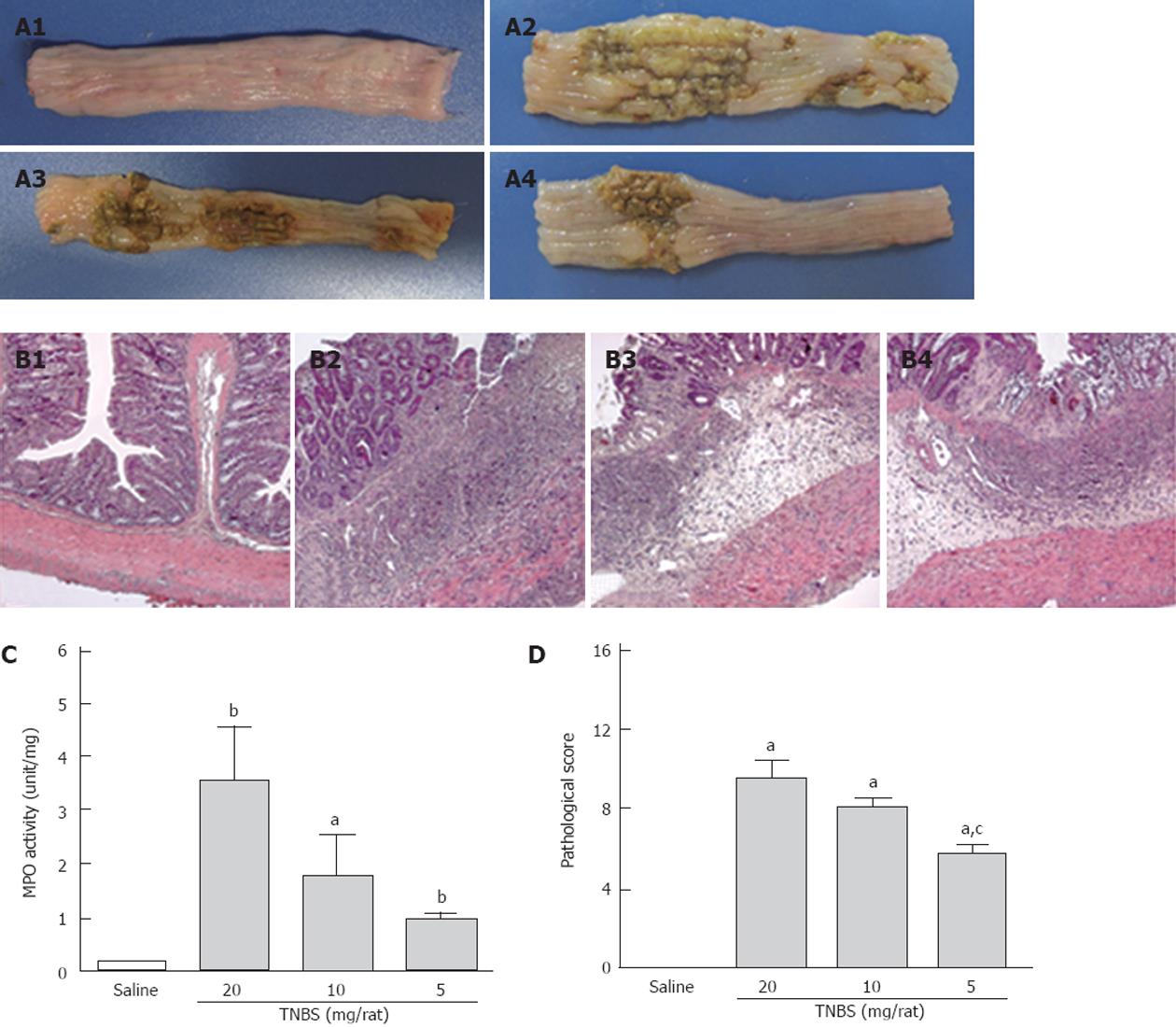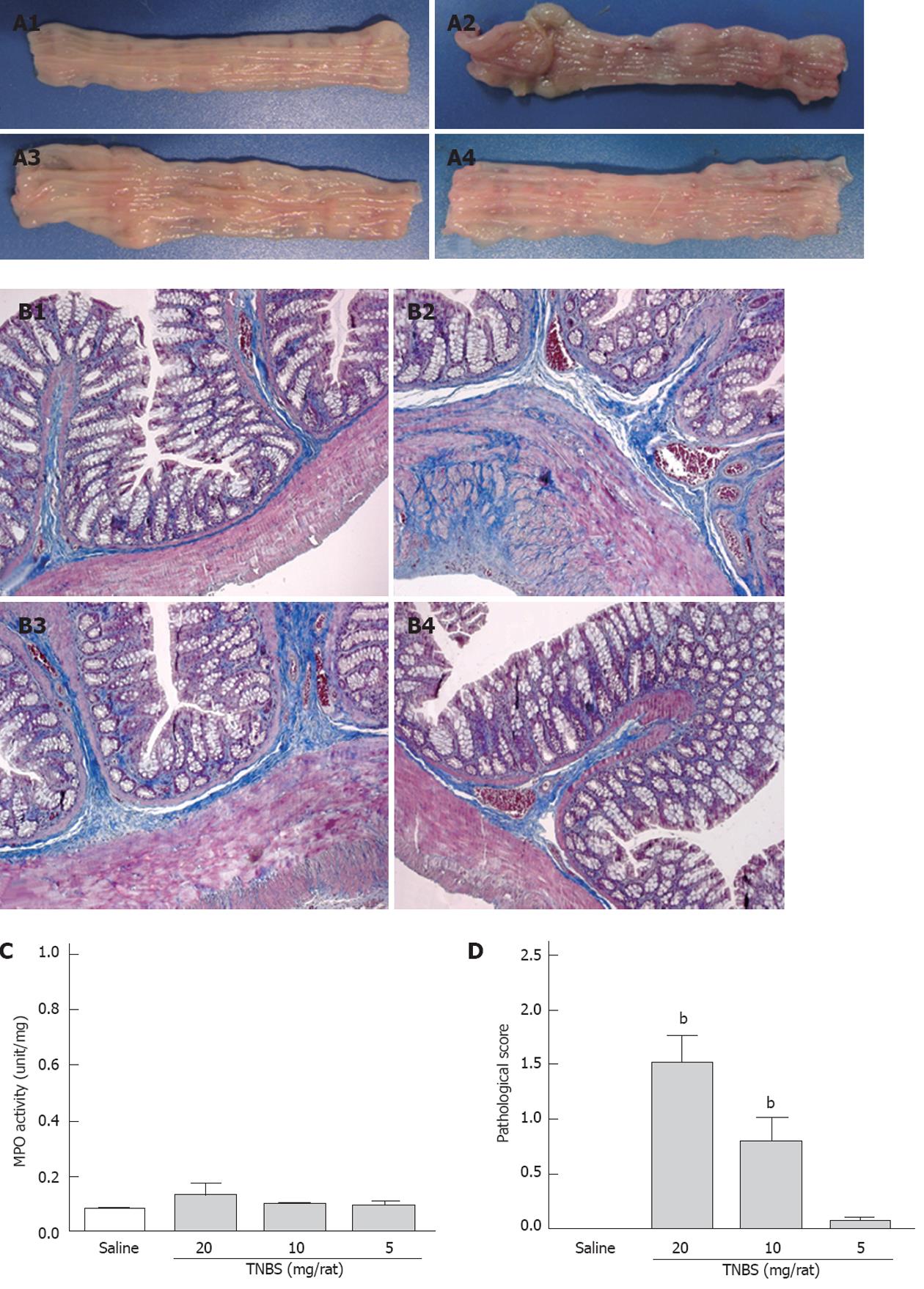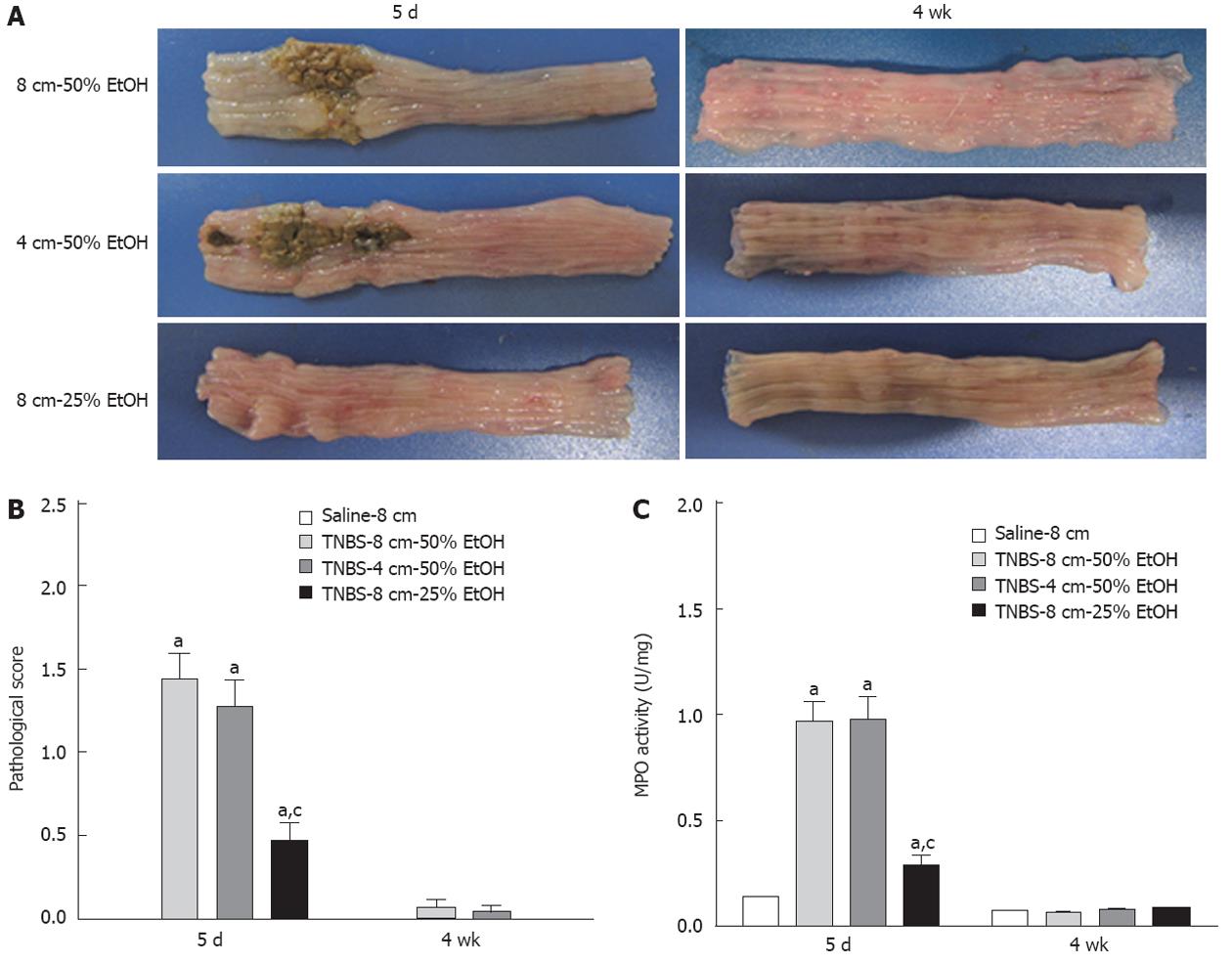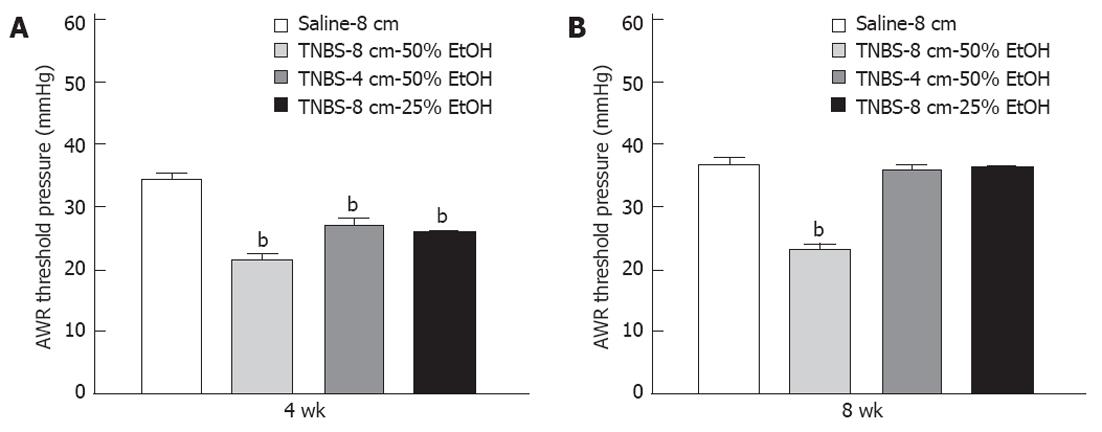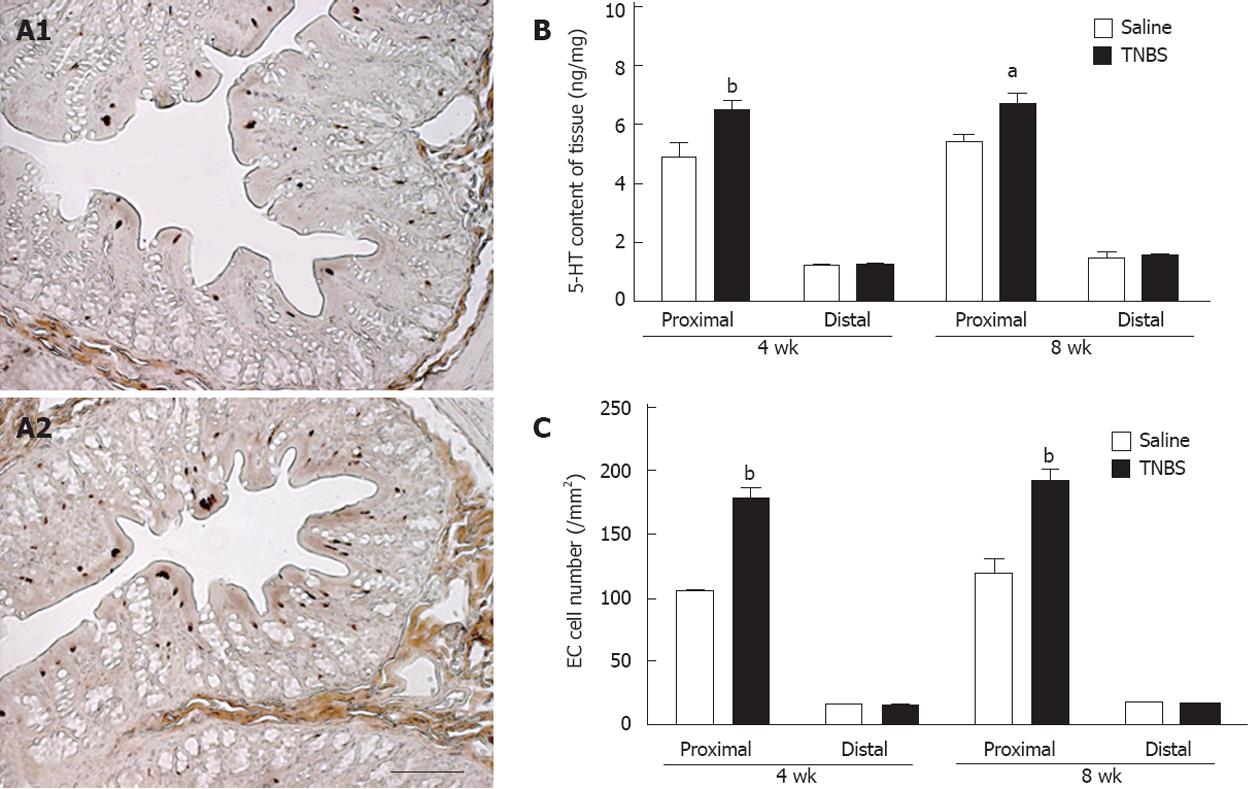Copyright
©2012 Baishideng Publishing Group Co.
World J Gastroenterol. May 28, 2012; 18(20): 2481-2492
Published online May 28, 2012. doi: 10.3748/wjg.v18.i20.2481
Published online May 28, 2012. doi: 10.3748/wjg.v18.i20.2481
Figure 1 Acute colonic inflammation and damage induced by different doses of trinitrobenzene sulfonic acid at 5 d after trinitrobenzene sulfonic acid administration.
Panel A depicts the appearance of colon tissue in saline (A1), high dose trinitrobenzene sulfonic acid (TNBS) (20 mg/rat, A2), medium dose TNBS (10 mg/rat, A3), and low dose TNBS (5 mg/rat, A4)-treated groups; Panel B depicts the representative histological changes of colon tissue in saline (B1), high dose TNBS (B2), median dose TNBS (B3), and low dose TNBS (B4)-treated groups (hematoxylin and eosin staining, 100×); Statistical analysis of myeloperoxidase (MPO) activity is shown in panel (C), and pathological score in panel (D). Data are shown as mean ± SE, n = 4 per group. aP < 0.05, bP < 0.01 vs saline-treated group; cP < 0.05 vs high dose TNBS-treated group (one-way analysis of variance, Student-Newman-Keuls).
Figure 2 Effect of trinitrobenzene sulfonic acid dosage on severity of acute inflammation and inflammation resolution.
The colon tissue was collected at 4 wk after trinitrobenzene sulfonic acid (TNBS) administration. Panel A depicts the appearance of colon tissue in saline (A1), high dose TNBS (20 mg/rat, A2), medium dose TNBS (10 mg/rat, A3), and low dose TNBS (5 mg/rat, A4)-treated rats; Panel B depicts the representative histological changes of colon tissue in saline (B1), high dose TNBS (B2), medium dose TNBS (B3), and low dose TNBS (B4)-treated rats (Masson trichrome staining, 100×); Statistical analysis of myeloperoxidase (MPO) activity is shown in panel (C), and pathological score in panel (D). Data are shown as mean ± SE, n = 4 per group. bP < 0.01 vs saline-treated group (one-way analysis of variance, Student-Newman-Keuls).
Figure 3 Effects of trinitrobenzene sulfonic acid administration position and ethanol percentage on severity of acute inflammation and inflammation resolution.
Panel A depicts the appearance of colon tissue in rats treated with trinitrobenzene sulfonic acid (TNBS) at 4 cm or 8 cm from anus or in 25% ethanol. The colon tissues were collected at 5 d or 4 wk after TNBS administration, respectively; Statistical analysis of pathological score is shown in panel (B), and myeloperoxidase (MPO) activity in panel (C). Data are shown as mean ± SE, n = 4-5 per group. aP < 0.05 vs saline-treated rats, cP < 0.05 vs rats treated with TNBS at 8 cm from the anus in 50% ethanol (one-way analysis of variance, Student-Newman-Keuls).
Figure 4 Effects of low dose trinitrobenzene sulfonic acid administration position and ethanol percentage on later acquired visceral hyperalgesia.
Statistical analysis of pain threshold pressure at 4 wk and 8 wk after trinitrobenzene sulfonic acid (TNBS) administration are shown in panel (A) and (B), respectively. Data are shown as mean ± SE, n = 5 per group. bP < 0.01 vs saline-treated rats (one-way analysis of variance, Student-Newman-Keuls). AWR: Abdominal withdrawal reflex.
Figure 5 Persistent increases of enterochromaffin cell number and serotonin content in the colon tissue of trinitrobenzene sulfonic acid-induced post-infectious irritable bowel syndrome rat model.
The colon tissue was collected at 4 wk and 8 wk after trinitrobenzene sulfonic acid (TNBS) administration. Panel A depicts the representative enterochromaffin (EC) cell staining in colon mucosa, the samples were from rats treated with saline (A1), or TNBS (A2) at 4 wk post TNBS (Scale bar, 100 μm). Statistical analysis of serotonin content is shown in panel (B), and EC cell number in panel (C). Data are shown as mean ± SE, n = 5 per group. aP < 0.05, bP < 0.01 vs saline-treated rats. 5-HT: 5-hydroxytryptamine.
- Citation: Qin HY, Xiao HT, Wu JC, Berman BM, Sung JJ, Bian ZX. Key factors in developing the trinitrobenzene sulfonic acid-induced post-inflammatory irritable bowel syndrome model in rats. World J Gastroenterol 2012; 18(20): 2481-2492
- URL: https://www.wjgnet.com/1007-9327/full/v18/i20/2481.htm
- DOI: https://dx.doi.org/10.3748/wjg.v18.i20.2481









